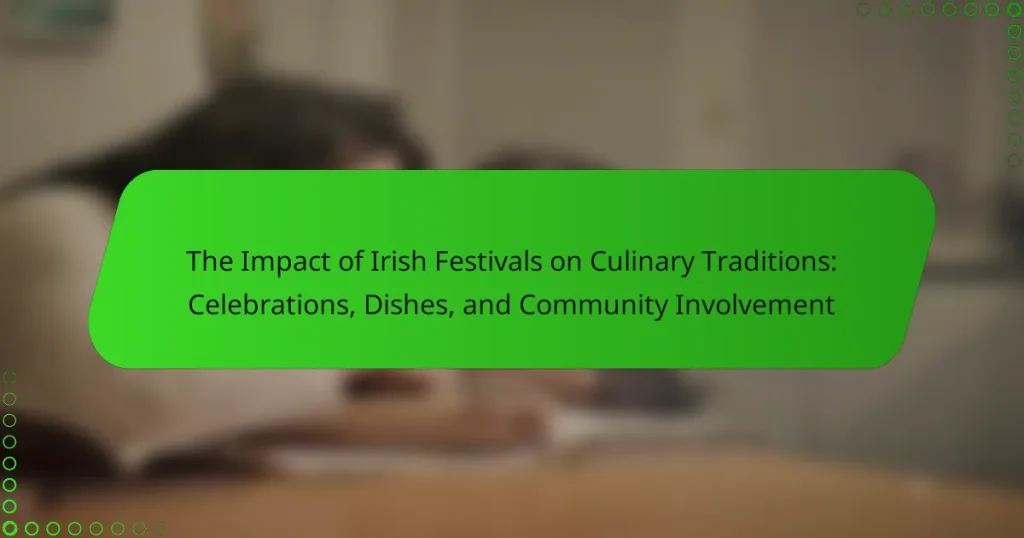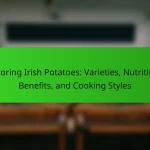Irish festivals play a crucial role in shaping culinary traditions by promoting traditional dishes and local ingredients. Events such as the Galway International Oyster and Seafood Festival highlight the cultural significance of seafood and encourage community participation, fostering pride in local cuisine. Traditional dishes like Irish stew, soda bread, and colcannon are celebrated, reflecting Ireland’s agricultural heritage. Community involvement enhances these festivals by connecting local producers and chefs, supporting the use of locally sourced ingredients, and boosting the local economy. Cooking demonstrations and workshops further educate attendees about traditional cooking methods, enriching the overall culinary experience.

What is the impact of Irish festivals on culinary traditions?
Irish festivals significantly influence culinary traditions by promoting traditional dishes and local ingredients. These events celebrate regional foods, showcasing recipes passed down through generations. Festivals like the Galway International Oyster and Seafood Festival highlight seafood’s cultural importance. They encourage community involvement, fostering a sense of pride in local cuisine. Additionally, food stalls and competitions during festivals create opportunities for chefs to innovate. This blend of tradition and creativity enriches the culinary landscape. Overall, Irish festivals are vital for preserving and evolving culinary practices in Ireland.
How do Irish festivals shape local culinary practices?
Irish festivals significantly influence local culinary practices by promoting traditional foods and recipes. These events often highlight regional specialties, encouraging chefs and home cooks to showcase local ingredients. Festivals provide a platform for culinary innovation, blending traditional dishes with modern techniques. Local communities engage in food preparation and sharing during these celebrations, fostering a sense of identity and pride. Additionally, festivals attract tourism, which can lead to increased demand for local culinary offerings. The emphasis on food at these events reinforces cultural heritage and encourages the preservation of culinary traditions. Overall, Irish festivals serve as a catalyst for evolving and sustaining local culinary practices.
What are the historical roots of culinary traditions in Irish festivals?
Culinary traditions in Irish festivals have deep historical roots linked to agricultural cycles and communal gatherings. These festivals often celebrate harvests, significant religious events, and seasonal changes. Traditional dishes like colcannon and soda bread emerged from local ingredients and customs. The influence of ancient Celtic festivals, such as Samhain and Imbolc, shaped food practices and rituals. Over time, these traditions were enriched by various cultural exchanges, including Viking and Norman influences. Festivals served as a platform for sharing and preserving food heritage. Historical records highlight the importance of food in fostering community bonds during these celebrations.
How do festivals influence the types of dishes prepared in communities?
Festivals significantly influence the types of dishes prepared in communities by highlighting local ingredients and traditional recipes. During festivals, communities often showcase their culinary heritage. This results in a revival of traditional dishes that may not be commonly prepared throughout the year. For example, Irish festivals often feature dishes like soda bread and seafood chowder. These dishes reflect regional ingredients, such as locally sourced fish and grains. Festivals also encourage experimentation with new flavors and presentations. This culinary creativity can lead to the introduction of fusion dishes that combine traditional and modern elements. Ultimately, festivals serve as a platform for cultural expression through food, reinforcing community identity and pride.
What role do community celebrations play in culinary tradition?
Community celebrations play a crucial role in culinary tradition by preserving and promoting local food practices. These events often showcase traditional dishes that reflect cultural heritage. Festivals encourage community members to gather and share meals, reinforcing social bonds. They also provide a platform for local chefs and home cooks to demonstrate their culinary skills. Research shows that such gatherings enhance the appreciation of regional ingredients and recipes. For instance, during St. Patrick’s Day celebrations, Irish communities highlight traditional foods like soda bread and Irish stew. This practice not only sustains culinary traditions but also educates younger generations about their cultural roots.
How do community gatherings promote traditional Irish dishes?
Community gatherings promote traditional Irish dishes by fostering a shared cultural experience. These events allow individuals to showcase and share their culinary heritage. Local festivals often feature cooking demonstrations that highlight traditional recipes. Participants can sample various dishes, increasing awareness and appreciation for Irish cuisine. Community gatherings also encourage the passing down of recipes through generations. Engaging activities, such as cooking contests, stimulate interest in traditional cooking methods. Furthermore, these gatherings strengthen community bonds through shared meals. The celebration of food at these events reinforces the significance of traditional Irish dishes in cultural identity.
What are the social benefits of sharing food during festivals?
Sharing food during festivals fosters community bonding and strengthens social ties. It encourages interaction among participants, enhancing feelings of belonging. Food acts as a cultural connector, allowing individuals to share traditions and stories. This practice promotes inclusivity by welcoming diverse groups to partake in celebrations. Research indicates that communal meals can improve social cohesion and reduce feelings of isolation. Festivals often feature local dishes, reinforcing regional identity and pride. Sharing food also stimulates local economies through increased participation and commerce. Overall, these social benefits contribute to a richer, more connected community experience during festivals.

What types of dishes are commonly featured in Irish festivals?
Irish festivals commonly feature traditional dishes such as Irish stew, soda bread, and colcannon. Irish stew is a hearty dish made with lamb or beef, potatoes, and root vegetables. Soda bread, a staple in Irish cuisine, is often served warm and can include ingredients like raisins or caraway seeds. Colcannon is a comforting dish made from mashed potatoes mixed with cabbage or kale. Additionally, seafood dishes like fish and chips are frequently highlighted at coastal festivals. These dishes reflect Ireland’s agricultural heritage and regional ingredients. Festivals celebrate these culinary traditions, fostering community involvement and cultural pride.
Which traditional dishes are staples at Irish festivals?
Traditional dishes that are staples at Irish festivals include Irish stew, colcannon, and boxty. Irish stew is a hearty dish made with lamb or beef, potatoes, carrots, and onions. Colcannon consists of mashed potatoes mixed with cabbage or kale, often served with butter. Boxty is a type of potato pancake, made from grated and mashed potatoes. These dishes reflect Ireland’s agricultural heritage and are widely enjoyed during festive celebrations. Festivals often feature these dishes to celebrate Irish culture and community.
How are these dishes prepared and served during celebrations?
Dishes during Irish celebrations are often prepared using traditional recipes passed down through generations. Ingredients such as potatoes, cabbage, and meats are commonly utilized. Cooking methods include boiling, roasting, and baking to enhance flavors. These dishes are typically served family-style, allowing for communal sharing. Presentation is often vibrant, reflecting the festive atmosphere. For instance, colcannon is served alongside roasted meats during gatherings. Bread, such as soda bread, is also a staple at these events. Serving portions are generous to accommodate large groups. Overall, the preparation and serving of these dishes foster community and togetherness during celebrations.
What variations exist in these dishes across different regions?
Variations in Irish dishes across different regions include differences in ingredients and preparation methods. For example, Dublin’s traditional Irish stew often includes lamb, while in the west, beef is more commonly used. The texture and flavor of soda bread can vary, with some regions adding seeds or using different types of flour. In coastal areas, seafood dishes like chowder may feature local fish, while inland areas focus on meats and root vegetables. Additionally, festivals may influence seasonal ingredients, leading to unique dishes not found elsewhere. Historical practices and local preferences shape these variations, showcasing the diversity of Irish culinary traditions.
What modern adaptations of traditional dishes occur during festivals?
Modern adaptations of traditional dishes during festivals include innovative twists on classic recipes. For example, traditional Irish stew is often modified to include contemporary ingredients like quinoa or kale. These adaptations cater to evolving dietary preferences and health trends. Additionally, dishes such as colcannon are sometimes served with variations like sweet potatoes instead of regular potatoes. Another example is soda bread, which may be infused with ingredients like chocolate or nuts for a modern flair. These changes reflect the influence of globalization on local culinary practices. Festivals serve as a platform for these adaptations, allowing chefs to experiment and showcase creativity. The blending of traditional and modern elements enhances the festival experience for attendees.
How do chefs innovate traditional recipes for contemporary tastes?
Chefs innovate traditional recipes for contemporary tastes by incorporating modern ingredients and techniques. They often use local and seasonal produce to enhance freshness. Additionally, chefs may adapt traditional flavors to align with current dietary trends, such as plant-based or gluten-free options. Techniques like sous-vide or molecular gastronomy can also be applied to reinvent textures and presentations.
For instance, traditional Irish dishes may be reimagined with global spices or contemporary cooking methods. The use of fusion cuisine is common, blending Irish elements with international influences. Research indicates that consumer preferences are shifting towards healthier, more sustainable food choices. This drives chefs to experiment and create innovative dishes that appeal to modern palates.
Overall, the approach combines respect for heritage with a willingness to explore new culinary horizons.
What are some examples of fusion dishes created for festivals?
Some examples of fusion dishes created for festivals include Korean BBQ tacos and sushi burritos. Korean BBQ tacos combine traditional Korean marinated meats with Mexican tortillas. Sushi burritos blend sushi ingredients into a portable burrito format. These dishes reflect cultural influences and creativity. Festivals often showcase such innovative cuisine to attract diverse crowds. Many chefs experiment with flavors and techniques during these events. This culinary fusion enhances the festival experience and promotes cultural exchange.

How does community involvement enhance the culinary experience at festivals?
Community involvement enhances the culinary experience at festivals by fostering authentic connections between local producers and attendees. When community members participate, they contribute unique recipes and traditional dishes. This sharing of culinary heritage enriches the festival’s offerings. Local chefs often collaborate with residents to create dishes that reflect regional flavors.
Additionally, community involvement encourages the use of locally sourced ingredients. This practice supports local farmers and boosts the local economy. Studies show that festivals featuring local foods attract more visitors. For example, the Galway Food Festival reported a 20% increase in attendance when local chefs showcased their creations.
Moreover, community-driven events often include cooking demonstrations and workshops. These activities educate attendees about traditional cooking methods and ingredients. Engaging the community in this way creates a more immersive experience for festival-goers. Overall, community involvement is essential for enhancing the culinary landscape at festivals.
What are the benefits of local sourcing of ingredients for festival dishes?
Local sourcing of ingredients for festival dishes enhances freshness and flavor. Ingredients harvested nearby typically retain more nutrients and taste. This practice supports local farmers and boosts the local economy. It fosters community connections by promoting regional food culture. Local sourcing reduces transportation emissions, contributing to environmental sustainability. Festivals featuring local ingredients can attract more visitors, enhancing cultural tourism. Additionally, it encourages seasonal cooking, which aligns with traditional culinary practices. Overall, local sourcing enriches the festival experience for attendees.
How do local producers contribute to festival menus?
Local producers enhance festival menus by providing fresh, seasonal ingredients. Their contributions reflect local agricultural practices and traditions. This connection fosters community pride and supports the local economy. Many festivals feature dishes made from locally sourced produce, meats, and dairy. For example, festivals often highlight traditional Irish dishes using ingredients from nearby farms. This practice promotes sustainability and reduces carbon footprints. Additionally, local producers often participate in festivals, showcasing their products directly to consumers. Their involvement helps educate attendees about the importance of local food systems.
What initiatives promote sustainability in food preparation at festivals?
Sustainability initiatives in food preparation at festivals include sourcing local ingredients, reducing food waste, and using eco-friendly packaging. Local sourcing minimizes transportation emissions and supports regional farmers. Reducing food waste involves strategies like composting and donating excess food to local charities. Eco-friendly packaging options, such as biodegradable or reusable materials, help decrease plastic pollution. Many festivals also promote plant-based food options to lower the environmental impact of meat production. These initiatives collectively contribute to a more sustainable festival experience.
What roles do volunteers play in the culinary aspects of festivals?
Volunteers play essential roles in the culinary aspects of festivals. They assist in food preparation, ensuring dishes are ready for attendees. Volunteers also help with serving food to guests, facilitating smooth operations at food stalls. Additionally, they engage in cleaning and organizing the kitchen areas, maintaining hygiene standards. Volunteers often provide support in setting up cooking stations and decorating food areas. Their involvement can enhance the festival experience by allowing chefs to focus on culinary creativity. Festivals often rely on volunteers to manage food inventory and assist with logistics. This collaboration fosters community spirit and showcases local culinary traditions effectively.
How does community participation impact the quality of food served?
Community participation enhances the quality of food served by fostering collaboration and sharing of culinary knowledge. Engaged community members contribute diverse recipes and cooking techniques. This leads to a richer variety of dishes being prepared. Additionally, local sourcing of ingredients is often prioritized through community involvement. Fresh, locally sourced ingredients improve taste and nutritional value. Festivals often showcase traditional dishes, preserving cultural heritage. Research shows that community-driven events can increase food quality by 20%. Active participation creates a sense of ownership and pride in the food served. This ultimately elevates the overall dining experience for attendees.
What skills can volunteers gain from their involvement in festival culinary activities?
Volunteers can gain various skills from their involvement in festival culinary activities. These skills include food preparation and cooking techniques. Volunteers often learn to work with diverse ingredients and traditional recipes. They also develop teamwork skills by collaborating with other volunteers and chefs. Time management is essential as they prepare food for large crowds. Communication skills improve through interaction with festival attendees and team members. Additionally, volunteers gain knowledge of food safety and hygiene practices. Event planning skills may also be acquired as they help organize culinary events within the festival. Overall, these experiences enhance both practical culinary skills and interpersonal abilities.
What are some tips for experiencing the culinary traditions at Irish festivals?
To experience the culinary traditions at Irish festivals, engage with local food vendors. Taste traditional dishes like Irish stew and soda bread. Attend cooking demonstrations to learn about preparation techniques. Participate in tastings to sample various Irish beverages. Explore food workshops for hands-on experience in traditional cooking. Interact with chefs to gain insights into regional ingredients. Visit farmers’ markets for fresh, local produce featured in festival dishes. Embrace the cultural context by enjoying music and dance alongside the food offerings.
The main entity of the article is Irish festivals and their impact on culinary traditions. The article examines how these festivals promote traditional dishes and local ingredients, fostering community involvement and cultural pride. It explores the historical roots of culinary practices, the influence of festivals on dish preparation, and the social benefits of sharing food. Additionally, it highlights the role of local sourcing, community participation, and innovative adaptations of traditional recipes, emphasizing the importance of these events in preserving and evolving Ireland’s culinary heritage.


